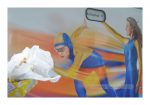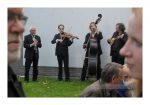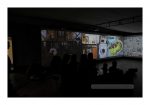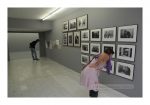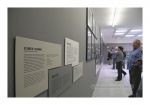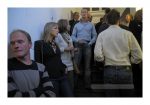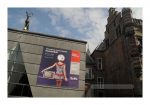NOORDERLICHT. To be continued
Apgailestauju – šis tekstas skirtas NOORDERLICHT festivalio palaikymui ir parašytas angliškai. Vertimo nebus.
Admiration of international image community and provinciality of Metropolis are the two poles that affect numerous PHOTO FESTIVALS of today.
The recent decision in the Netherlands to no longer finance NOORDERLICHT has been one of the hottest topics of the world-wide image community.
I visited NOORDERLICHT exhibition only once, not as KAUNAS PHOTO festival (Lithuania) director, as I usually travel to festivals, but as contributing curator and a selected artist in 2008 in the exhibition “BEHIND WALLS: Eastern Europe before & Beyond 1989”.
I can firmly say, that the exhibition about Eastern Europe by NOORDERLICHT was probably the most impressive, comprehensive group exhibition I’ve ever seen.
Being a director of KAUNAS PHOTO festival, based in the second-largest town of Lithuania, I have a couple of insights to share.
My own trip to the opening of NOORDERLICHT show “Behind the Walls” was kind of an epical journey. 5 AM, Kaunas > car ride to Vilnius airport > 7:30 AM flight to AMSterdam > 9:30 AM several trains and >> at midday I am in Leeuwarden, located in an “uncomfortable” spot of the Netherlands.
Regardless of the effort to get there, a really rewarding experience awaited me at the exhibition opening. Hundreds of people packing the museum building. Creative layouts of the exhibition. Tens of artists present at the opening. Exhibition itself – could almost be looked at as a small encyclopedia of the Eastern European social image. The only two aspects of discussion among fellow artists & curators was that most people travelled far to get to the show, but they were neither presented to the audience, nor to each other. And secondly, some famous curators argued that the choice of artists was sometimes opportunistic, Eastern Europe being richer than the selection on the walls. Well, but that’s probably the Nordic European way to do things… And then, having visited tens of photographic festivals, knowing their façades, and often also the kitchen, I can frankly say that I can hardly name few editions of festivals as perfect or ideal, but NOORDERLICHT for sure, was HUGE, GREAT, AMAZING, INCREDIBLE, etc.
- Leeuwarden railway station. My train home-wards. Sprinter and my fish and chips. September 7, 2008
- Noorderlicht, Leeuwarden, Fries museum. Behind Walls – opening. Curator Wim Melis. September 6, 2008
- Noorderlicht, Leeuwarden, Fries museum. Behind Walls – opening. Curator Wim Melis. September 6, 2008
- Noorderlicht, Leeuwarden, Fries museum. Behind Walls – opening. The social part. September 6, 2008
- Noorderlicht, Leeuwarden, Fries museum. Behind Walls – exhibition. Part 2 – after 1989 – projection with my works from “Portrait of Kražiai”. 2008
- Noorderlicht, Leeuwarden, Fries museum. Behind Walls – exhibition. Part 2 – after 1989 – projection with my works from “Portrait of Kražiai”. 2008
- Noorderlicht, Leeuwarden, Fries museum. Behind Walls – exhibition. Part 2 – after 1989 – authors’ overview. 2008
- Noorderlicht, Leeuwarden, Fries museum. Behind Walls – exhibition. 2008
- Noorderlicht, Leeuwarden, Fries museum. Behind Walls – exhibition opening. Me (right), colleagues, organizers.. 2008
- Noorderlicht, Leeuwarden, Fries museum. Behind Walls – exhibition. 2008
- Noorderlicht, Leeuwarden, Fries museum. Behind Walls – exhibition. 2008
- Noorderlicht, Leeuwarden, Fries museum. Behind Walls – opening. September 6, 2008
- Noorderlicht, Leeuwarden, Fries museum. Behind Walls – opening time. September 6, 2008
- Noorderlicht, Leeuwarden, Freis museum. 2008
The next day after the opening I returned to Kaunas, where the following day KAUNAS PHOTO festival started. We, in the second biggest Lithuanian city, have have that sort of a typical problem. Some people from Vilnius, the capital city, including professionals in culture and art find it difficult to take a 100 km ride and see what’s beyond the walls of their Metropolis. During the opening event of our festival we had several hundreds of people, of course, mainly of the local audience, but also photographers from Europe, US, Thailand. But very few people coming from the capital, Vilnius.
There is a lot of public discourse around the complex of provinciality in general, but cases of PHOTO FESTIVALS are very particular. It is quite normal that trends get accumulated, approved, enjoyed in the Metropolis and then exported back to where they came from. The PHOTO FESTIVAL is now in this situation.
Looking back in the history of the phenomenon, the PHOTO FESTIVAL, we find that it is a pure construct of the “province” in regard to the the Metropolis, with a clear statement, that photography can be celebrated in a different way than just being published in newspapers and shown in the most official museums and galleries.
With few exceptions until recently, it was the same everywhere: PHOTO FESTIVALS were based outside the “gate” cities of the countries. So initially the complex of inferiority in regard to photography celebration resided in Metropolis.
In the late 1960s, Lucien Clergue had difficulties persuading French minister of culture (a writer) to support a photographers’ meeting in Arles, being forwarded to address the issue to someone else, but not him, e.g. ministry of sports.
In the 1980s, Founders of Houston FOTOFEST, Wendy Watriss & Fred Baldwin had to face suspicious looks from museums of New York, who before FOTOFEST used to exhibit the classical imagery over and over, without taking a look at the contemporary photographic creation, of, say, Japan. And then, most of the artists exhibited in those big museums after Houston, were often presented as discoveries of Metropolis.
In 2003 in Odense, Denmark, the on last day of the FUNEN PHOTO FESTIVAL, I revisited Finn Thrane, the director of Brandts museum of photography and organizer of the festival at his office. I caught him at the landline phone trying to get some journalists from Copenhagen, the capital of Denmark, be interested to cover the festival of photography, exhibitions of which were all around the Funen Island, not just in Odense. It seemed like no-one was about to take a train crossing the bridge over the sea from Copenhagen and see what’s in the town of H.C.Andersen. For me, who was about to launch KAUNAS PHOTO festival in Lithuania, it was a sign that the media of Metropolis is no longer interested in the fairy tales of an artsy small town.
In Finland, the second-largest town of Tampere, there used to be one of the greatest triennales of photographic art, BACKLIGHT. I say it in past tense, because the festival used to mainly rely on successful funding from the European Union, while the 2011 edition did not. I do not know the reasons. I am sure it continues to be a GREAT festival, but unfortunately, it is no longer HUGE.
In Lithuania, KAUNAS PHOTO festival started in 2004, at that time being the pioneering festival of photography in the Baltic states. Since 2006, KAUNAS PHOTO festival, alike NOORDERLICHT, is also a state-funded festival. It appears that only the opening of the 8th edition in 2011 was honoured by the presence of the Minister of Culture of Lithuania. And one day, it is possible that we face the same answer, as NOORDERLICHT received, stating that we do not have enough of theoretic dimension, we do not generate flows of tourism as a bikers’ festival does, or an argument of a similar absurdity.
Today we have New York, Copenhagen, Helsinki, Vilnius and numerous others Metropolis based PHOTO FESTIVALS, like Paris, London, Sydney etc. I am glad with the fact itself that PHOTO FESTIVAL is a legitimate way of celebration of the image art. We see it approved.
But does it mean that those, who started the PHOTO FESTIVALS from scratch, created photographic cultures in countries and regions, need to become closed chapters of the cultural history? I am sure it is a wrong attitude.
Even if a culture / arts officer from the capital city / Metropolis needs to extend the working day with change of several trains, crossing the sea by bridge or drive a drowsy motorway to get there for an opening and discover what is a PHOTO FESTIVAL admired by thousands, NOORDERLICHT and other off-capital festivals are be continued.
By the way, when it is about national funding…
A “province” based PHOTO FESTIVAL is usually a lot less costly and more cost-effective than one in Metropolis.
Mindaugas Kavaliauskas
KAUNAS PHOTO festival director
Kaunas, Lithuania




